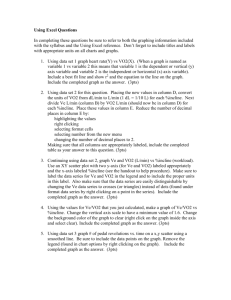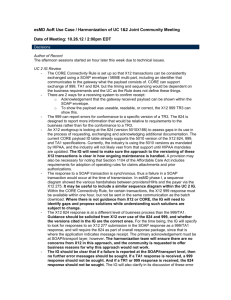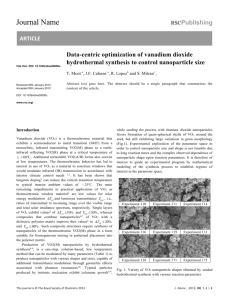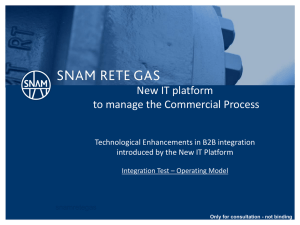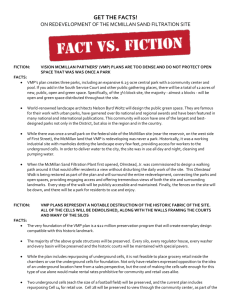supporting_info_APL
advertisement
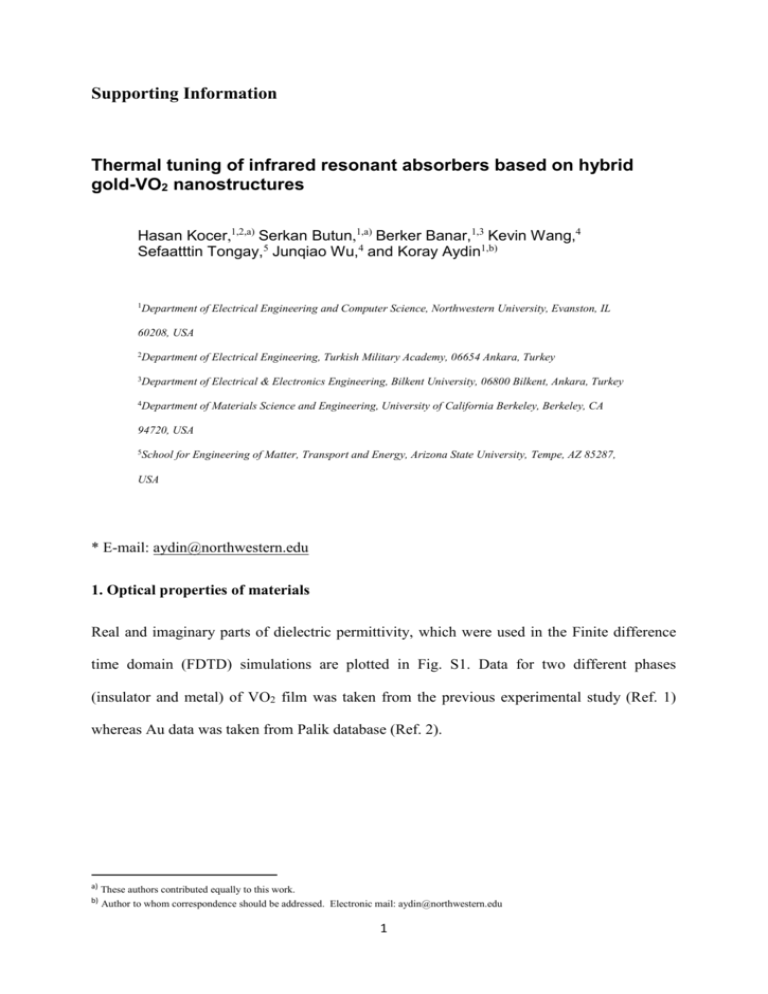
Supporting Information Thermal tuning of infrared resonant absorbers based on hybrid gold-VO2 nanostructures Hasan Kocer,1,2,a) Serkan Butun,1,a) Berker Banar,1,3 Kevin Wang,4 Sefaatttin Tongay,5 Junqiao Wu,4 and Koray Aydin1,b) 1Department of Electrical Engineering and Computer Science, Northwestern University, Evanston, IL 60208, USA 2Department of Electrical Engineering, Turkish Military Academy, 06654 Ankara, Turkey 3Department of Electrical & Electronics Engineering, Bilkent University, 06800 Bilkent, Ankara, Turkey 4Department of Materials Science and Engineering, University of California Berkeley, Berkeley, CA 94720, USA 5School for Engineering of Matter, Transport and Energy, Arizona State University, Tempe, AZ 85287, USA * E-mail: aydin@northwestern.edu 1. Optical properties of materials Real and imaginary parts of dielectric permittivity, which were used in the Finite difference time domain (FDTD) simulations are plotted in Fig. S1. Data for two different phases (insulator and metal) of VO2 film was taken from the previous experimental study (Ref. 1) whereas Au data was taken from Palik database (Ref. 2). a) These authors contributed equally to this work. b) Author to whom correspondence should be addressed. Electronic mail: aydin@northwestern.edu 1 Figure S1. Wavelength dependence of real (ε1, plotted in solid lines) and imaginary (ε2, plotted in dashed lines) parts of dielectric permittivity of (a) Au and (b) insulating phase of VO2 (black-colored lines) below the phase change temperature and metallic phase of VO2 (red-colored lines) above the phase change temperature. (Au data is from Ref (2) and VO2 data is from Ref (1)). 2. Maps of electric field intensity If we compare the electric field intensity (|E|2) confinement inside the g-design at the resonant wavelength of 2.6 µm, we note that |E|2 of the i-VO2 [Fig. S2(a)] is highly localized around the top of the VO2 stripes in comparison to quite low |E|2 localization around the same place of the m-VO2 [Fig. S2(b)]. Furthermore, when we turn to c-design, at the resonant wavelength of 2.3 µm, similar field intensity localizations (Figure S2c and S2d) were obtained. Again, |E|2 of the i-VO2 (Figure S2c) is highly localized around the top of the VO2 slab along the x-axis in comparison to quite low |E|2 localization around the same place of the m-VO2 (Figure S2d). 2 Figure S2. At 2.6 µm resonant wavelength, electric field intensity, |E|2, map of the g-design (a) at room temperature (i-VO2), (b) at high temperature (m-VO2). At 2.3 µm resonant wavelength, |E|2 map of the c-design (at sapphire interface) (c) at room temperature (i-VO2), (d) at high temperature (m-VO2). 3. Methods 3.1 VO2 growth The VO2 thin films were grown epitaxially by pulsed laser deposition on double side polished sapphire substrates at 500 °C. A vanadium metal target was used as the source material and deposition took place in 10 mTorr oxygen pressure with a growth rate of ~4 nm/min. 100 nm thick VO2 films were deposited with a 300 mJ laser pulse at a laser repetition rate of 5 Hz. Because of the relatively well established growth process, sapphire 3 was chosen as a substrate. In addition, sapphire transmits IR radiation fairly well up to 6 µm which is suitable for the scope of this work. 3.2 Sample fabrication For the fabrication of the nanostructured samples, first, poly(methyl methacrylate) (PMMA) resist was coated by spin coating. PMMA was processed by e-beam writing and the sample was developed by using IPA and MIBK (3:1). Then, structures were trasfered to VO2 layer by reactive ion etching (RIE). The remaining PMMA was removed by using acetone. Finally, 200 nm Au was e-beam deposited by using evaporation. This gold deposition fills the grating or cylindrically etched regions of 100 nm thickness and also coats another 100 nm over the device. 3.3 Spectral Measurements Experimental reflection measurements of the fabricated samples were carried out using an infrared microscope (Bruker Hyperion 2000) and the Fourier transform infrared (FTIR) spectrometer (Bruker Vertex 70) with a liquid nitrogen cooled mercury cadmium telluride detector and near-IR source. Reflected light was collected with a 15x magnification reflective objective (Numerical aperture 0.4). For the calibration we used reflection data of sapphire on thick gold region as the reference. In order to induce phase transition, samples were heated above the 68 C0, using a heating stage that is mounted on the IR microscope, with a temperature controller (Thorlabs TC200). i-VO2 (insulator phase) and m-VO2 (metallic phase) states were observed at 23 oC (room temperature) and at 123 oC (hot temperature), respectively. After adjusting the controller of the heating stage, we waited at least one minute to let the sample reach to the target temperature. In addition, in g-design sample, measurements were carried out for two different polarizations (parallel to the gratings and 4 perpendicular to the gratings) but in c-design, measurements were done with only unpolarized light due to the symmetry of the structure. 3.4 FDTD simulations Full-field electromagnetic wave simulations were performed using Lumerical, a commercially available FDTD simulation software package. The unit cells of the g-design and c-design structures were simulated using periodic boundary conditions along the x and y axes, and perfectly matched layers along the propagation of electromagnetic waves (z axis). Plane waves were launched incident to the unit cell along the +z direction, and reflection was monitored with a power monitor placed behind the radiation source. Electric fields and absorbed power were detected within the frequency profile and power monitor. In the FDTD simulations, complex refractive indices for two different phases (insulator and metal) of VO2 film were taken from earlier experimental study [1]. Index of the sapphire was set to the constant value of 1.7 since it was assumed to be lossless in our spectral wavelength range of interest. Complex refractive index of Au were taken from Palik database [2]. Wavelength dependence of real (ε1) and imaginary (ε2) parts of corresponding dielectric permittivity for Au, insulating and metallic phases of VO2 are plotted in Fig. S1. REFERENCES 1. 2. Dicken, M.J., et al., Frequency tunable near-infrared metamaterials based on VO2 phase transition. Optics Express, 2009. 17(20): p. 18330-18339. Palik, E.D., Handbook of Optical Constants of Solids II. 1998: Elsevier Science. 5

